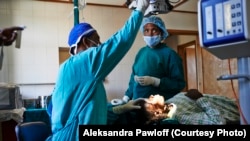Trachoma is a preventable and treatable eye disease and is the second leading cause of blindness in Ethiopia. In a country of 96 million people, nine million children under nine years have active trachoma. Left untreated, trachoma leads to trichiasis, an eyelid abnormality in which eyelashes grow inward toward the eye, scratching the cornea and causing blindness.
Light for the World, a confederation of NGOs trying to eradicate trachoma from Ethiopia and the world, says 1.3 million Ethiopian adults are in need of eyelid surgery.
They have been working with local partners in the Tigray region of northern Ethiopia to treat people with trachoma, the leading cause of infectious blindness in the world. By acting now, the confederation hopes in the next five years to eradicate the disease.
One of the key strategies used in the region is a project developed by the World Health Organization called SAFE, an acronym for Surgery, Antibiotics, Face Washing, Environmental Sanitation.
At the May Keya Primary and First Cycle School in Dedeba Village in the Tigray Region of northern Ethiopia, healthworker Gebre Selassie said they dispense antibiotics for prevention of Trachoma and provide vital information regarding eye health.
He said health workers stress the importance of reinforcing the SAFE strategy to eradicate trachoma and Light For The World works with local communities to educate people on this strategy.
“Currently we are doing team implements of the SAFE strategy, which is the prevention strategy of trachoma and here we are conducting two main activities,” Selassie said. “Number one is distribution of antibiotics for active trachoma. And the second one is operating on people for those who have a chronic stage of trachoma and disease.”
In Gamera Village, The Gamera Health Center provides eye care services to approximately 8,000 people in the area. One of them is 40-year-old Tewures Asseja, the mother of five children.
Tewures waits to see the doctor along with other patients for diagnosis of her eye condition which she thinks is trichiasis. If this is what is bothering her she will need surgery to prevent blindness in the eye. She explained why she was at the clinic.
“To treat my eye—I have a discomfort on my eye and I have a vision problem," she said. "Because I have severe pain -- discomfort -- so I will not be afraid for the surgery.”
A nearby male eye patient waiting to see the surgeon for a follow-up exam broke in,“I am very happy. At the initial time I was afraid, but now I am comforted.”
Another patient, a young woman sat quietly in the pre-op area at the Quiha Eye Hospital Vision Center in Mekele, waiting for surgery for her glaucoma. Others at the clinic also waited for surgery which could cost as much as $1,000. However, patients are allowed to pay what they can, with donors paying most of the cost.
Dr. Tilahun Kiros, an ophthalmologist at the vision center, explained the procedure he was about the perform on the patient.
“The procedure is called trabeculotom. Just what I make is, I make a flap… a fistula to by-pass the normal pressure, then the flow of the eye…flows with that fistula outside to the sub-conjunctive area going to the other reserve,” the surgeon said.
If the words failed to give her a satisfactory picture of what was about to take place, his voice reassured her that it could work.
Glaucoma is a condition of the eye that leads to damage to the optic nerve. It is often associated with a build-up of pressure inside the eye. In many cases, medication and eye drops can relieve the pressure. However, sometimes surgery is needed to relieve the eye pressure. Though the prognosis for recovery is good, Kiros said it will not bring back sight that has already been lost.
“The glaucoma surgery just maintains that vision—the existing vision. It will not improve—just maintain from getting worse,” he said.
His colleagues say Kiros is very good with his hands and works efficiently. He has to, because he has many patients to treat. This is just another busy day of the week at the Vision Center. Despite the pressure of the schedule, he displays a gentleness and kindness towards his patients.
Light For The World, helps Kiros and other doctors and health workers achieve their goal of making sure patients get the proper care for their eyes so that they can get on with their lives.








